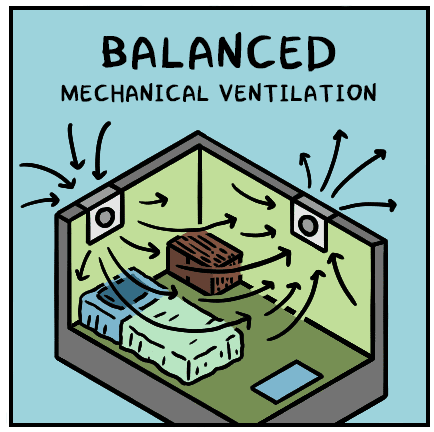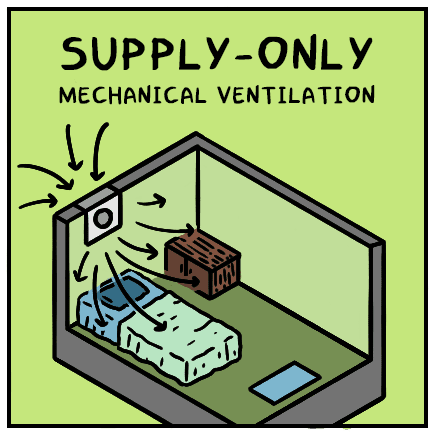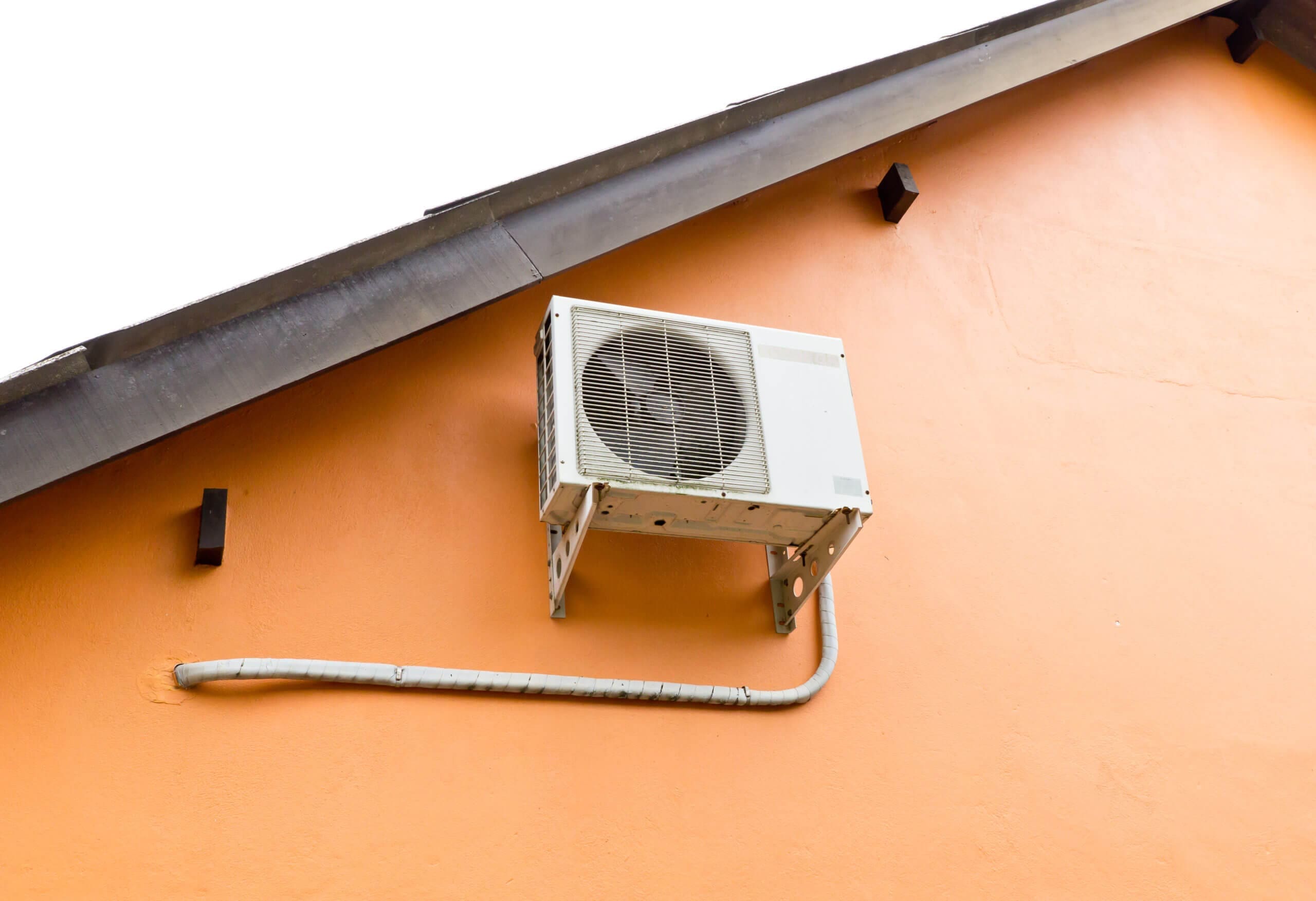Ventilation is a crucial and necessary process for every indoor space. It has an impact on a little bit of everything in our daily life.
Good ventilation benefits house quality as well as the health and well-being of those living in the home. A well-ventilated space helps reduce indoor odors, mold growth, harmful pollutants, headaches and even allergies.
But what are the best home ventilation systems to ensure this process?
We break down the three types of ventilation and why relying on the previously thought of go-to isn’t enough anymore. We also break down the three types of mechanical ventilation systems and why whole-home upgrades are best.
Considering there are quite a few options on the market, make sure you’re informed about the best choice for your home before discussing with a contractor!
Ventilation has a tremendous effect on indoor air quality which is why your home ventilation system matters.
Why Is Ventilation Important?
At its simplest, ventilation is purely the exchange of indoor and outdoor air.
Exchanging fresh new air and stale old air is a seemingly easy process. But there are multiple ways to ventilate an indoor space and a couple of different mechanical home ventilation systems to choose from that aid the process.
Ventilation is necessary because, without the new-old air exchange, harmful indoor air pollutants are stuck circulating inside. And what’s stuck circulating inside, you and your family are stuck breathing. There is a multitude of factors that affect indoor air quality. Things like excessive moisture, poor humidity regulation, pets in the home, gases from cooking and all sorts of factors worsen air quality. They’re also the factors that make ventilation even more critical.
It’s All About Your Health
- Breathe easy: Ventilation replaces stale air with fresh, oxygen-rich air
- Kick allergens to the curb: Dust, dander, mold – a well-ventilated home shows them the door
- Say goodbye to mold: Excess moisture creates problems, ventilation keeps things dry and safe
A Comfortable & Fresh Home
- Keep your cool: Good airflow aids temperature control, even reducing AC needs slightly
- Banish bad smells: No more lingering cooking or pet odors
- Feel the difference: Ventilation gives your home that crisp, fresh feeling
Protect Your Investment
- Prevent costly damage: Moisture buildup leads to rot – ventilation is your home’s best defense
- Extend appliance life: Less strain on AC units means they last longer
Ventilation is particularly important today as modern building standards and construction codes have resulted in more airtight homes and buildings.
Air used to seep into homes through cracks in the home’s foundation and breaks around windows or doors.
Without the help of natural ventilation and the inability to control or filter natural ventilation sources, the sole importance is on mechanical ventilation.
Three Types of Ventilation
To understand the whole-home mechanical ventilation options, you first need a better understanding of how ventilation is at work in your home already.
Natural Ventilation
Natural ventilation is simply uncontrolled air. Compared to fan-forced ventilation (AKA mechanical ventilation), natural ventilation is caused by natural factors. It is quite literally outdoor air entering an indoor space on its own. In every kind of space, opening windows or doors and letting fresh air in is an example of natural ventilation. A strong breeze is the easiest manifestation.
In older homes and builds specifically, natural ventilation is also the air that enters through unsealed spaces. This can be cracks in the wall or foundation of the home as well as a basement or crawl space and is known as infiltration.
Historically, this was the most common ventilation method and part of the reason mechanical ventilation was largely unnecessary until recently. Because most indoor spaces were leaky or drafty and allowed a certain amount of air in, additional forced ventilation processes weren’t needed.
Spot Ventilation
Spot ventilation is the use of localized exhaust fans. It is a form of mechanical ventilation. Spot ventilation uses fans to exchange air, but it is localized to a specific area of the home only. Think kitchen or bath fans, for example.
These extremely concentrated ventilation systems aim to remove pollutants and odors (like those caused by cooking) or remove excess moisture from a space (as caused by a shower). These localized systems used to be the extent of mechanical ventilation in homes.
Whole-Home Ventilation
Now, mechanical ventilation systems have evolved into whole-home ventilation systems. A whole-home or whole-building system uses one or multiple fans and ductwork to effectively bring fresh outdoor air indoors and remove stale indoor air.
The goal of a home ventilation system is to both improve indoor air quality and effectively ventilate a large space.
A whole-home system is incredibly beneficial. There is a consistent influx of fresh air and the removal of stagnant air. It is consistently working to improve the quality of the air supply.
Because the process can use a space’s existing ductwork and installs directly into the HVAC system, whole-home ventilation systems can provide controlled ventilation to an entire house.
Plus, by using the existing HVAC system, the air is also filtered, resulting in cleaner, healthier indoor air.
Three Types of Whole-Home Mechanical Ventilation Systems
Think of ventilation quite literally as your home’s lungs. Proper ventilation keeps homes fresh and occupants healthy. This is why we recommend upgrading to a whole-home mechanical ventilation system. When it comes to whole-house ventilation options, there are a few types to choose from.



Exhaust-Only
Exhaust-only ventilation effectively rids a space of stale indoor air. It is relatively inexpensive and an easy ventilation system to maintain. It usually only requires one fan and one exhaust point in the home. (Again—think of localized bathroom or stove exhaust fans.) This ventilation process improves indoor air quality because it removes stale air, which is often full of harmful and hazardous indoor air pollutants. Exhaust-only systems usually work better in colder weather climates.
There are a few drawbacks to an exhaust-only system that are worth mentioning. The main problem is that the process draws air out of the home without a dedicated source to provide fresh air to make up for the difference. The resulting change in pressure, or depressurization, means the space itself actively pulls in air from cracks, leaks and vents in the home to create the necessary balance. Depressurization is even more harmful in warmer climates because moisture isn’t removed from the air before it enters the home. Thus, the change in pressure increases the threat of moisture damage. Because exhaust-only systems cannot dry the air before it enters the space, these ventilation systems also often increase heating and cooling costs, making them less energy-efficient and cost-effective.
Another issue with exhaust-only systems is the concern that they worsen indoor air quality. This is rooted in studies that have shown exhaust-only systems draw in additional indoor pollutants and contaminants from poor air quality spaces. Areas of the home such as an attic, garage or basement. (Keep in mind, the space is desperately trying to balance the depressurization effect and looking to any and every source for more air!) For homes with shared walls such as row homes, condos or apartment buildings, air quality becomes dependent both on your home habits and those of your neighbors. Overall, exhaust-only is too difficult to control to consider a good home ventilation system.
Supply-Only
Supply-only ventilation does the opposite of exhaust-only systems, instead, filling an indoor space with fresh outdoor air. It does so by using a fan or several fans to draw outdoor air indoors. Examples of supply-only systems are an attic HVAC fan. With supply-only, to ensure good indoor air quality, make sure to choose one location to serve as the fresh air source. This will limit the number of indoor pollutants entering the home. Supply-only ventilation systems work best in warm climates.
Similar to exhaust-only, there is no dedicated balance method. In this case, that means there is no process that helps rid the space of old stale air, resulting in pressurization. This ventilation system simply forces old air to leak out of the home or building through existing cracks and holes as well as localized fans and vents. Also similar to the exhaust-only system, moisture is not removed from the incoming air beforehand. Meaning—moisture damage is still a threat and increased AC and heating costs are also likely.
Supply-only ventilation systems are able to provide fresh air for several rooms in a home. Most homeowners will choose to focus the supply-only home ventilation system’s efforts on the rooms they occupy the most.
Balanced
As the name suggests, a balanced home ventilation system combines the exhaust and supply processes. It takes the best of the exhaust-only and supply-only systems, without any of the additional problems to create the best overall whole-home ventilation system.
Balanced home ventilation systems effectively bring in fresh outdoor air (supply) and force out stale polluted indoor air (exhaust). Depressurization and pressurization are not a concern with balanced home ventilation systems because they efficiently provide and remove equal amounts of air, keeping the home in a state of equilibrium.
A balanced ventilation system requires two fans and two duct systems to both pump in the fresh air and remove stale air. Many balanced ventilation systems are able to share existing HVAC system ductwork. However it can be more expensive if additional ductwork is needed, the exact cost depends on how much duct is already in your home. It’s important to keep in mind that balanced systems are more cost-effective in the long run. This is because the HVAC system does not have to work harder for temperature control. Rather, balanced home ventilation systems help heat and cool air during the ventilation process.
To break down home ventilation one final time … there are two types of balanced home ventilation systems.
Heat Recovery Ventilator
A heat recovery ventilation system (HRV) transfers heat between the old exhaust air and new fresh air. The air streams never mix during this process. Because an HRV effectively transfers heat, the system also helps keep heating costs low. An HRV is often recommended for colder climates.
Energy Recovery Ventilator
An energy recovery ventilation system (ERV) transfers both heat and moisture between the old exhaust air and new fresh air. The goal is to minimize energy loss during the ventilation process. And because it exchanges heat and moisture, ERVs help with temperature control. An ERV keeps the air moist, cool and humid during the summer and warm in the winter. ERVs are usually recommended for warmer climates.
Upgrading to a Balanced Whole-Home Ventilation System
Whether you opt for an HRV or ERV, both are incredibly helpful whole-home ventilation systems. Ensuring consistent good ventilation for your indoor space has almost immediately noticeable effects. We can help you better understand which whole-home system would work best in your space or help find an IAQ expert in your area!




